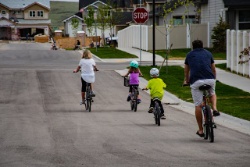Children drinking too many sweet drinks
Children drinking too many sweet drinks
Children are getting most of their sugar intake and much of their carbohydrate from sweetened drinks, most of which have no, or few, other useful nutrients.
The National Children’s Nutrition Survey found sweetened drinks are second only to bread in supplying carbohydrate in children’s diets. Eleven percent of their carbohydrate intake comes from sweetened drinks ahead of potatoes, kumara and taro (9 percent), fruit (8 percent}, sugar and sweets (6 percent) and breakfast cereals (6 percent). The drinks provided the main source of sugar for children.
The older children (11-14 years) surveyed drank more soft drinks than the younger children. Fifty-four percent of the older children drank Coca Cola and other cola based drinks at least once a week. Around 31 percent of 5- 6 year and 36 percent of 7 -11 year olds drank them at least once a week.
“In the days before there was an obesity epidemic soft drinks and cola drinks were a special treat but today kids are drinking them as every day thirst quenchers.” says Celia Murphy, Executive Director of the Obesity Action Coalition. “Softdrinks and sweetened powdered drinks provide only energy (calories) – they have no other useful nutrients. What’s more they are really damaging to the teeth.”
A study carried out in the US and published earlier in the year showed that children who drank more sweetened drinks a day than other children were more likely to gain a significant amount of weight because they did not eat less to compensate for the extra energy (calories) they consumed in the drinks. Ms Murphy says “The advertising for cola based drinks is strongly directed at adolescents and it seems it is successful – the older kids in the survey drank more of these drinks than the younger ones. The advertising images are all about beautiful people having lots of active fun but the reality is pretty bleak. Many of the children and young people drinking a lot of these drinks are not active and are overweight or obese. More than 12 percent of the children in the survey got no physical activity during weekends and around 49 percent watched more than 8 hours of television in the weekend. Walking for at least 15 minutes a day was the most common activity reported by the children.”
“Soft drink vending machines have no place in schools and tuckshops should not stock soft drinks” says Ms Murphy “This won’t stop children drinking these sweetened drinks but limiting access to them at least during school hours may help to reduce consumption. If children are overweight then every opportunity to reduce energy intake will help and children who are not overweight but inactive don’t need the extra energy these drinks provide.”


 FASD-CAN: People With Fetal Alcohol Spectrum Disorder (FASD) Dismayed At Government’s Response To The Rights Of Disabled People
FASD-CAN: People With Fetal Alcohol Spectrum Disorder (FASD) Dismayed At Government’s Response To The Rights Of Disabled People NZ Opera: Jane Austen Opera Coming To Christchurch & Dunedin - South Island Premiere | NZ Opera’s Mansfield Park Returns This April
NZ Opera: Jane Austen Opera Coming To Christchurch & Dunedin - South Island Premiere | NZ Opera’s Mansfield Park Returns This April Sport Manawatū: Women’s Health Series Empowers Women To Prioritise Their Wellbeing
Sport Manawatū: Women’s Health Series Empowers Women To Prioritise Their Wellbeing Pure Adventure Charitable Trust: Iconic One New Zealand GODZONE To Make Triumphant Return To New Zealand’s Adventure Racing Scene
Pure Adventure Charitable Trust: Iconic One New Zealand GODZONE To Make Triumphant Return To New Zealand’s Adventure Racing Scene The Charter School Agency: New Charter Schools Open Doors To First Students
The Charter School Agency: New Charter Schools Open Doors To First Students  The Wednesday Challenge: Tauranga Travel Initiative Goes National
The Wednesday Challenge: Tauranga Travel Initiative Goes National